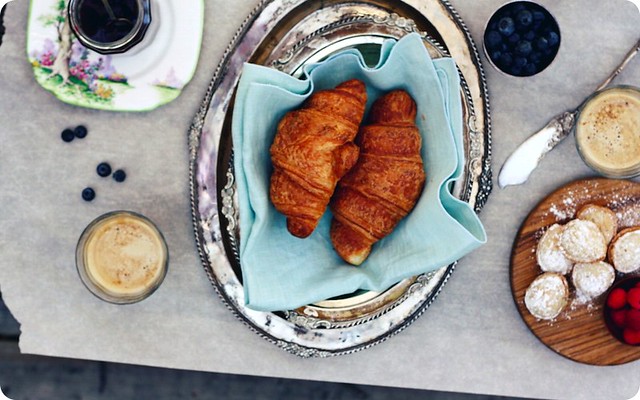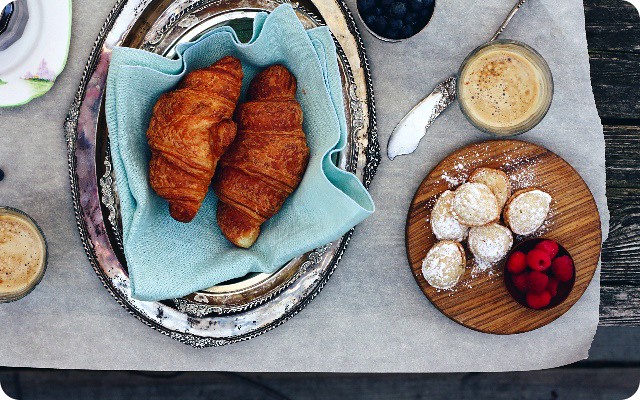Before we get into things, I should explain that button way up there on the left. I'm honoured to say that this site has been nominated in two (!) categories in Saveur's 2011 Best Food Blog Awards, namely Best Food Photography and Best Original Baking and Desserts Recipe (for this Frozen Raspberry Eton Mess). If you'd like to vote, you can head to Saveur.com because the polls close soon - if you live outside the US and Canada, pretend we're neighbours and pick either country. Your ballot will be counted without trouble.
In other news we just passed the six year anniversary of me writing here. Once again, I can't thank you enough for reading.
Edited, May 13 - the voting's now closed for the Saveur awards, so I've removed the button to save any confusion. I'm grateful for all the support.
*******
My Mum used to make a drink she called cappuccino, and I remember one of my cousins was particularly fond of it. I took it for granted that the funny preparation of coffee was a peculiarity of our kitchen alone because it was unlike any other cappuccino I'd ever seen. I didn't think much of it. In fact, I don't think I've thought anything of it, let alone made it, for at least a decade.
I pity all those wasted years.
Never fear, I'm making up for lost time. Mum's concoction has been my recent addiction and the undisputed star of this morning's late-morning breakfast.
A few weeks back, Prerna mentioned "Indian espresso coffee" elsewhere and it piqued my interest. When I was a child and we were in India, and when home here, my parents made their coffee in stovetop percolator or Moka pot. They later moved to a French press and there may be a small electric maker tucked away somewhere, but I can't be sure of that. We were, as you might imagine, more of a tea-drinking household; the times that a pot of coffee made an appearance were few and far between.
That said, those rare occasions weren't the only times there was coffee in our kitchen.
My earliest recollection of Mum's "cappuccino" places me at about 10 years old, furiously mixing a blend of sugar and instant coffee powder in the bottom of a cup. In went hot water and milk, and the combination would magically blend then divide, with a layer of thick foam above a rich, milky coffee below.
In the memory I'm too young to drink the final preparation, but I remember being fascinated by the process. The phenomenon is not unlike the settling of a pint of Guinness, actually - subtract the alcohol and add a (major) hit of caffeine, and you've got a picture of what it looks like.
What Prerna was referring to was exactly that same drink; in a moment, Mum's brew that had been ours alone was all of a sudden shared in millions of Indian memories, and what I took for granted was in fact an (inter)national treasure.
I feel a tad flushed-in-the-cheeks to be extolling a beverage made with such an enthusiastic amount of sugar and instant coffee, a substance usually banished to the shadows of the baking cupboard. I'll get over it, no worry there, as while this may not be an everyday kind of drink I'll encourage its once-in-awhile presence at the table. If you're a fan of Vietnamese coffee, then you're already halfway convinced. This coffee has the same uncompromising intensity, the same weighty, toasted, caramel flavours that makes Vietnamese so provocatively good.
To dispel my childhood ignorance, I asked my father about Indian espresso one night after dinner. With a small smile and taking up the spoon I was using to whip up a batch, he told me it was a drink he and his friends used to make to impress girls. Girls before he'd met my mother, even. Scandalous.
According to Dad, an offer to "beat the coffee" was up there with volunteering to do the dishes after a meal. I like that idea, and am tossing my name in for the job, even though my father hasn't lost his touch and still makes it far better than I ever will.
You might consider to do the same, as the effort expended is far outmatched by the accolades that follow. The "beating" is a method as straightforward as you could hope for - while some milk and water heat in a pot, take a cup and stir together instant coffee granules with some sugar, barely dampened with water.
Now's when everything gets interesting; you start to stir and stir with all your might and as quickly as you can muster. As air is incorporated into the mix, it goes first frothy, than fluffy - if ever you've made hollandaise or zabaglione, the coffee behaves much like the egg yolks there. It doubles in size, transforming into an ethereal mass of bubbles - rewardingly smooth, the coffee looks a pale caramel, the same colour as the crema that floats the top of a shot of properly-pulled espresso.
That's the bulk of the work done and dusted, and it only takes a minute or two. After that it's pour and stir to finish the business.
Mum's away at present. Her return was already anticipated but is now even moreso since we'll be catching up over a cup of her not-so-secret recipe. I've got the date marked on the calendar, and I won't forget the coffee.
Frothy Indian Coffee
My family's way, with thanks to Prerna for the reminder and Soma for such a lovely story (and super-helpful step-by-step photos for anyone who needs them). An espresso-style instant coffee is best here.
Ingredients
3/4 cup milk
1/4 cup water, plus around 1/2 teaspoon more
4 teaspoons sugar, or to taste, I like Turbinado
1 tablespoon instant coffee powder
In a small saucepan over medium heat bring the milk and water to a simmer, stirring occasionally.
Meanwhile, in a cup or measuring jug, stir together the sugar with the instant coffee powder. Add a few drops of water and stir again. The mixture should look moist and sandy but not soaked.
With a spoon, start beating the mixture vigorously; use the back of the spoon to press the granules against the side of the vessel to help break them down. As you stir, the mixture should lighten from dark brown to clay in colour and begin to thicken. Add a few more drops of water only if needed.
Once the mixture is past clay and truly pale, smooth and quite viscous (it should behave like softly-whipped cream and ribbon back upon itself when dripped from a spoon), pour in some of the hot milk and stir to dissolve, making sure to scrape down the sides and bottom of the vessel so that no sediment is left behind. Divide the mixture between two small cups, and then divide the remaining hot milk between the two, giving each a quick stir if necessary.
Enjoy hot, or cold over ice. Serves 2.
Notes:
- A word of caution, beating the coffee mixture can etch the sides of ceramic cups. Keep this in mind, or do as I do and use a Pyrex measuring cup to measure the liquids, then use that again to beat the coffee.


